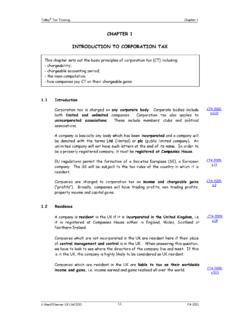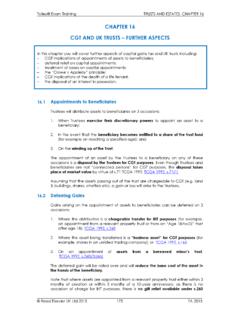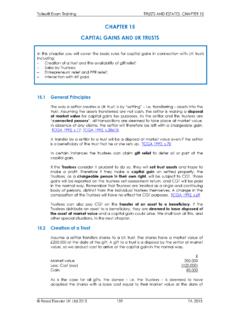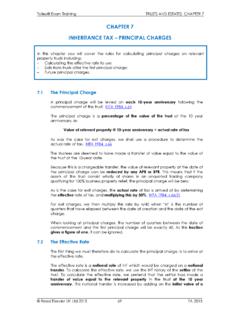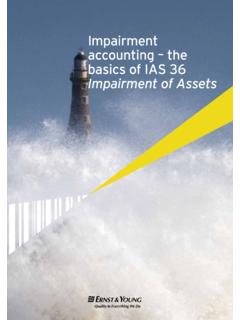Transcription of CHAPTER 12A LOAN RELATIONSHIPS - BASICS
1 Tolley Exam Training CHAPTER 12A. CHAPTER 12A. loan RELATIONSHIPS - BASICS . This CHAPTER looks at loan RELATIONSHIPS covering in particular: - the definition of a loan relationship ;. - the treatment of income and expenses;. - the purpose of the loan relationship ;. - non trade loan relationship deficits;. - prior period adjustments;. - capitalised interest;. - ceasing to be UK resident, and - loans for unallowable purposes. Definition A company has a loan relationship if it: CTA 2009, owes or is owed money as a result of a money debt, and that debt arose from a transaction for the lending of money. A money debt is generally one that is settled by the payment of cash. A money debt can also be settled by the transfer of another money debt or the CTA 2009, issue or transfer of shares. A transaction for the lending of money includes not just the actual lending of money, but also the creation of debt by issuing an instrument to evidence the debt.
2 An instrument is a written promise to repay a debt notes, bonds, or bills of exchange between a borrower and a lender. Illustration 1. A bank loan is a loan relationship as it arose from the lending of money, and is a money debt as the company will settle the debt through the payment of cash. A trade creditor (where goods or services are paid for on a later date in accordance with credit terms) is a money debt as it will be settled in cash. However it did not arise as a result of the lending of money and as such is not a loan relationship . Reed Elsevier UK Ltd 2012 FA 2012. Tolley Exam Training CHAPTER 12A. Likewise, the person who provided the goods or services and is owed the money (the trade debtor) does not have a loan relationship . The provision of a service is not the lending of money. However, if an instrument (a written promise to repay a debt) is drawn up to evidence the amount owed as a result of the work done, that is a transaction for the lending of money and creates a deemed loan relationship that will be settled in cash.
3 Interest, impairment losses (bad debts) and foreign exchange gains and losses on CTA 2009, & 479. money debts are always included in the loan relationship rules, even if the underlying debt is not a loan relationship . Example 1. Which of the following constitute a loan relationship ? a) Debentures in a company b) Government gilts c) Bank deposit account d) Bank overdraft e) Debtors ledger f) loan to an employee Treatment of income and expenses The legislation uses accounting terminology so you must ensure that you are familiar with these terms: Debits are expenses Credits are income loan relationship income and expenses include: CTA 2009, Interest payable and receivable, Foreign exchange gains and losses, CTA 2009, Costs to issue the debt, Debt collection costs, Pre- loan and abortive expenses, CTA 2009, Profit or loss on the acquisition or disposal of an existing loan relationship CTA 2009, (called a related transaction), Reed Elsevier UK Ltd 2012 FA 2012.
4 Tolley Exam Training CHAPTER 12A. Loans written off (known as impairments or bad debts) this would result in an expense in the company writing the debt off, Release of loans this is where the debtor is no longer required to pay back the loan . This would result in: o an expense in the company which has released the debt, and o income in the company that has had their obligation to pay the CTA 2009, debt released (unless the release is part of a statutory insolvency arrangement). For tax purposes we follow the accounting treatment, we account for income CTA 2009, (4). and expenses on an accruals basis. This means that we will generally use the income and expenses in the Profit and Loss Account (UK) or Income Statement (International) produced by the company as these will have been prepared in accordance with UK or International generally accepted accounting practices. We also take into account any profits and losses shown in the company's Statement of Total Recognised Gains and Losses (UK) or Statement of Changes in Equity (International).
5 One exception to this is the writing off or release of a loan to a participator CTA 2010, of a close company which had given rise to a section 455 tax charge in the company. This write off or release will be treated as dividend income for the shareholder CTA 2009, involved as they no longer have to repay the loan to the company. No deduction is allowed for the expense in the close company. Example 2. Which of the following are eligible for tax relief under the loan relationship rules? a) Interest payable b) Early redemption penalties c) Bank arrangement fees d) Amounts written off loans (bad debts). e) Loss on disposal of loan stock Reed Elsevier UK Ltd 2012 FA 2012. Tolley Exam Training CHAPTER 12A. Example 3. Soria Ltd borrows 10,000,000 from a bank on 1 March 2012 for trade purposes. Interest of is payable quarterly in arrears. The fees for arranging the loan came to 75,000 and were payable in full on 1 March 2012.
6 When the documentation for the 5 year loan was put in place. Calculate the amount of corporation tax deduction available for the loan in respect of Soria Ltd's year ended 30 September 2012. Purpose of the loan relationship We need to establish the purpose of the loan relationship to determine on which line of the corporation tax computation the income and expenses need to be included. If the loan was for trade purposes, any associated income and expenses would be included in the calculation of trade profits. A loan will have a trade purpose if the funds are used to generate income which is taxed as trade profits. Examples of a loan for trade purposes include: a loan to buy plant and machinery or a factory for use in the company's trade, a bank overdraft to fund the working capital of the business, and a bank loaning money to its customers. However, if the loan relationship arose for non trade purposes, the income and expenses on these non trade loans are pooled together and included as non trade loan relationship income or deficit for the period.
7 Examples of non trade loan RELATIONSHIPS include: a loan to buy an investment property or shares, a company loaning money to its employees or customers, a company receiving interest on positive bank deposits, and interest on overpaid or underpaid corporation tax CTA 2009, Reed Elsevier UK Ltd 2012 FA 2012. Tolley Exam Training CHAPTER 12A. Example 4. Classify the following loans as trading or non trading: a) loan to buy a factory b) loan to buy rental premises c) loan to buy shares on the stock market d) loan to buy shares in a trading subsidiary company e) Funds lent to a subsidiary for the purpose of its trade. Non trade loan relationship deficits If, having pooled together all of the non trade income and expenses a deficit arises, it can be relieved in the following ways: 1. Offset in the current year against total profits before qualifying CTA 2009, (1)(a). charitable donations.
8 The company can choose the amount it wishes to set off against total profits, it is not an all or nothing claim. 2. Carried back against non trade loan relationship income in the previous 12 CTA 2009, (1)(b). months. A carry back claim is all or nothing. This means that if there is sufficient deficit to do so, the non trade loan relationship income must be taken down to nil. The non trade loan relationship deficit available to carry back is the deficit of the current year to the extent that it has not been relieved by a current year or group relief claim. 3. Carried forward against non trade income. This is automatic so no claim is CTA 2009, required. A claim can be made to offset only part of the loss in the accounting period immediately following the deficit period and carry forward a larger deficit, or CTA 2009, to skip' that period entirely and wait until the following period to offset the deficit.
9 4. A group relief claim can be made for any amount of the loss. CTA 2010, These claims are independent and can be made in any order. All claims must be made within 2 years of the deficit period. Reed Elsevier UK Ltd 2012 FA 2012. Tolley Exam Training CHAPTER 12A. Prior year adjustments Prior year adjustments are made when a company: changes the accounting policies it uses, or has made a fundamental error in a previous period. The company will need to restate the prior year accounts to ensure that the figures are comparable and that the brought forward figures are accurate. The tax treatment depends on the reason for the prior year adjustment. An income or expense due to a change in accounting policy is included for tax CTA 2009. purposes as if it were incurred on the first day of the period in which the change occurred. However if the change is due to a change in accounting standards, such as a move SI 2004/3271.
10 Reg 3A. from UK to International GAAP, the adjustment is spread over 10 years starting with the year in which the change occurred. If the company ceases to be within the charge to corporation tax before the end SI 2004/3271. reg 3A. of the 10 year period, the remaining income or expense is brought in the final accounting period. An income or expense due to the correction of a fundamental error in a prior CTA 2009, (3). period is treated for tax purposes as occurring in the period in which the error occurred. This may mean that returns for previous periods need amending, and tax may become payable by or repayable to the company. Illustration 2. Portico Plc holds debentures in Mora Ltd, an unconnected company. In the accounts to 31 December 2012 the debentures were recorded at 100,000 as the company was using amortised cost accounting. In the year to 31 December 2013 Portico Plc adopts IAS and as a result the debenture is restated at its fair value of 122,000.
